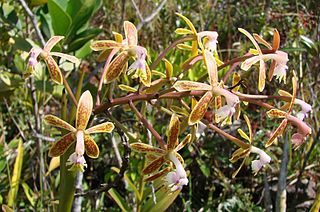
Epidendrum flexuosum, a reed-stemmed Epidendrum common at mid-altitudes in Central America, is a species of orchid commonly called Epidendrum imatophyllum. It grows exposed to intense sunlight in the forest canopy, particularly on Guava species. E. flexuosum bears non-resupinate lavender flowers on a congested raceme at the end of a long peduncle.

Epidendrum anceps, literally the "two-edged upon a tree," a species of epiphytic orchid in the genus Epidendrum, is sometimes known as the brown epidendrum or dingy-flowered epidendrum.

Epidendrum armeniacum is an epiphytic species of reed-stemmed Epidendrum orchid that grows wild in Bolivia, Brazil, Ecuador, and Peru, at altitudes of 1–2 km.

Epidendrum cristatumRuiz & Pav. (1789) is a species of orchid in the genus Epidendrum which is known to grow both terrestrially and epiphytically at altitudes near 1 km in the Neotropics from Mexico and Belize down through Brazil, as well as Trinidad.

Epidendrum compressum is a species of orchid in the genus Epidendrum from wet montane forests of Trinidad, Venezuela, Colombia, Ecuador, Peru and Bolivia.

Epidendrum friderici-guilielmi is a species of orchid in the genus Epidendrum which grows naturally at altitudes of 1.7—3.0 km. in Peru and Bolivia.

Epidendrum rigidum is an epiphytic reed-stemmed Epidendrum orchid common throughout the Neotropical lowlands, below 600 m (2,000 ft).
Epidendrum dendrobii is a terrestrial species of reed-stemmed Epidendrum of the Orchidaceae which grows on steep slopes in tropical montane cloud forests of Cochabamba, Bolivia and Venezuela at altitudes near 2.6 km.
Epidendrum smaragdinum is an epiphytic sympodial orchid native to the Neotropics. It has been found at 0.5 km above sea level in Napo, Ecuador It is also known from Brazil, French Guiana, Guyana, Peru, Suriname, and Venezuela.
Epidendrum tridens is a terrestrial orchid closely allied to E. nocturnum, of which it has often been considered a variety or synonym. For example, Reichenbach 1861 lists Epidendrum tridens(Poepp. & Endl.) Cogn. (1898) as a synonym of Epidendrum nocturnum and Epidendrum nocturnum var. latifoliumLindl. (1837) as a distinguishable variety of Epidendrum nocturnum.

Epidendrum calanthum is a terrestrial reed-stemmed Epidendrum orchid from the montane Tropical rainforest of Bolivia, Colombia, Ecuador, Peru, Venezuela, and the West Indies.
Epidendrum spruceanum is an epiphytic reed-stemmed Epidendrum orchid native to the Tropical rainforest of Peru, Bolivia, and Brazil.
Epidendrum alpicola is a tropical orchid native to Bolivia, Colombia, Ecuador, Peru, and Venezuela at altitudes from 1.8—2.7 km.

Epidendrum lacustre is a sympodial orchid which is known to grow both epiphytically and lithophytically in the cloud forests and rainforests of Colombia, Costa Rica, Ecuador, Nicaragua, Peru and Venezuela at altitudes ranging from 1.2—2.5 km. The type of this species was found growing "on half-submerged rotten trees" in a Venezuelan marsh at an altitude of 2.4 km.
Epidendrum adenoglossum is an orchid known primarily from its type herbarium specimen, Mathews 1073, collected in Peru near Pangoa. When Lindley published the name, he placed the species in the subgenus E. subg. SpathiumLindl. (1841). In 2005, Hágsater & Soto designated this species as the lectotype of E. subg. SpathiumLindl. (1841).

Epidendrum catillus is an epiphytic orchid native to Colombia, Ecuador and Peru at altitudes ranging from 0.8 km to 1.6 km.
Epidendrum cochlidium is a neotropical orchid which can grow both terrestrially and epiphytically in Peru and Venezuela at altitudes ranging from 1.2 km to 2.9 km.

Epidendrum coriifolium is a sympodial orchid which grows both terrestrially and epiphytically at altitudes of 1.4—1.7 km in dense forests in Brazil, Ecuador, Mexico, Central America, and Venezuela.

Epidendrum cylindrostachys is an epiphytic orchid native to the mountainous rainforest of Colombia and Peru, at altitudes near 2.5 km. According to the World Checklist, this binomial has no synonyms or homonyms.
Epidendrum stenophyton is an Epidendrum orchid native to Bolivia, Ecuador, Peru and Venezuela.















